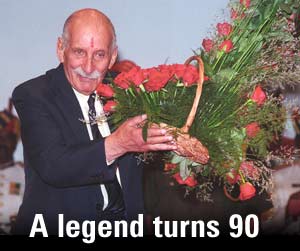Field Marshal Sam Hormusji Framji "Sam Bahadur" Jamshedji Manekshaw MC (April 3, 1914 – June 27, 2008) was an Indian Army officer. In a long career spanning nearly four decades, Manekshaw rose to be the 8th Chief of Staff of the Indian Army in 1969 and under his command, Indian forces concluded a victorious campaign during the Indo-Pakistani War of 1971.
Sam Manekshaw was the first of only two Indian military officers to hold the highest rank of Field Marshal of the Indian Army (The other being Field Marshal K M Cariappa). His distinguished military career spanned four decades and through five wars, including World War II.
Early life and education

Manekshaw was born in Amritsar, Punjab to Parsi parents who immigrated to the Punjab from the small town of Valsad on the Gujarat coast. After completing his schooling in Amritsar and Sherwood College (Nainital), he joined the first batch of 40 cadets at the Indian Military Academy, Dehradun on 1 October 1932. He passed out of the IMA in December 1934 and was commissioned as a Second Lieutenant in the Indian Army. He held several regimental assignments and was first attached to the Royal Scots and later to the 4/12 Frontier Force Regiment.
Military career

Manekshaw's military career spanned four decades, from the British era and World War II, to the three wars against China and Pakistan after India's independence in 1947.
World War II

During World War II, Manekshaw saw action in the Burma campaign on Sittang River as a Captain with the 4/12 Frontier Force Regiment [1] and has the rare distinction of being honoured for his bravery on the battle front itself. During World War II, he was leading a counter-offensive against the invading Japanese Army in Burma. During the course of the offensive he was hit by a burst of LMG bullets and was severely wounded in the stomach. Major General D.T. Cowan spotted Manekshaw holding on to life and was aware of his valour in face of stiff resistance from the Japanese. Fearing the worst, Major General Cowan quickly pinned his own Military Cross ribbon on to Manekshaw saying, "A dead person cannot be awarded a Military Cross."
Higher Commands and Offices

Having recovered from those near-fatal wounds in Burma, Manekshaw went for a course at Staff College, Quetta and later also served there as an instructor before being sent to join 12 Frontier Force Rifles in Burma under General (later Field Marshal) Slim's 14th Army. He was once again involved in a fierce battle with the Japanese, and was wounded for a second time. Towards the close of World War II, Manekshaw was sent as Staff Officer to General Daisy in Indo-China where, after the Japanese surrender, he helped rehabilitate over 10,000 POWs. He, then, went on a six-month lecture tour to Australia in 1946, and after his return served as a First Grade Staff Officer in the Military Operations Directorate.
Manekshaw showed acumen for planning and administration while handling the issues related to Partition in 1947, and later put to use his battle skills during the 1947-48 Jammu & Kashmir Operations. After command of an Infantry Brigade, he was posted as the Commandant of the Infantry School and also became the Colonel of 8 Gorkha Rifles (which became his new regimental home, since his original parent regiment The 12th Frontier Force Regiment went on to join the new Pakistan Army at partition ) and 61 Cavalry. He commanded a Division in Jammu & Kashmir and a Corps in the North East, with a tenure as Commandant of Defence Services Staff College (DSSC) in between. As GOC-in-C Eastern Command, he handled the tricky problem of insurgency in Nagaland and the grateful nation honoured him with a Padma Bhushan in 1968.
Army Chief: The War of 1971

Manekshaw became the 8th Chief of Army Staff when he succeeded General Kumaramangalam on 7 June 1969. His years of military experience were soon put to the test as thousands of refugees from the erstwhile East Pakistan started crossing over to India as a result of oppression from West Pakistan. The volatile situation erupted into a full-scale war in December 1971.
During this Indo-Pakistani War of 1971, Manekshaw showed uncommon ability to motivate the forces, coupling it with a mature war strategy. The war ended with Pakistan's unconditional surrender, and the formation of Bangladesh. More than 45,000 Pakistani soldiers and 45,000 civilian personnel were taken as POWs. He masterminded the rout of the Pakistan Army in one of the quickest victories in the recent military history. This led to the Shimla Agreement which opened the door to the creation of the nation of Bangladesh as separate from Pakistan.
Honour and Retirement


For his distinguished service to the country, the President of India awarded him a Padma Vibhushan in 1972 and conferred upon him the rank of Field Marshal on 1 January 1973. Manekshaw became the first of the only two Indian Army Generals to be awarded this prestigious honorary rank; the other being the late Field Marshal Kodandera Madappa Cariappa. Manekshaw retired a fortnight later (although technically Field Marshals of the Indian Army never retire because the rank is conferred for life), on 15 January 1973, after completing nearly four decades of military service.
Following his retirement from the Indian Army, Manekshaw successfully served as a director of numerous companies.
He died of complication from pneumonia at the Military Hospital in Wellington, Tamil Nadu on 0030 hours, June 27th, 2008 at the age of 94.
JAI HIND !!!!!!


0 comments:
Post a Comment